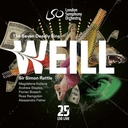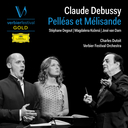Juditha Triumphans (1716) was one of four oratorios that Vivaldi wrote and the only one to survive, although the overture has been lost. Based on the Book of Judith, the work, with libretto by Iacopo Cassetti, describes Judea under attack from the Assyrian King Nebuchadnezzar, who demands overdue tributes. His army, under the general Holofernes, has laid siege to the city of Bethulia, and is poised to conquer it. The young Jewish widow Juditha goes to him to implore mercy, and ends up disarming him with her beauty. He invites Juditha to dine with him, and after he falls asleep, having had his fill of wine, she seizes the opportunity to kill him. She returns to the Judeans with his head, and they rejoice at the enemy having been defeated and Bethulia saved.
The work was commissioned to celebrate the victory of the Republic of Venice over the Turks following the latter’s siege of Corfu. This began in July 1716 when the Turks landed on the island, but the population resisted the occupation. This provided the time for Venice to sign an alliance with the Holy Roman Emperor, and on 18 August, under the leadership of Count Johann Matthias von der Schulenburg, the allies defeated the Turks who abandoned the island. The similarities between the two scenarios are obvious, and even referenced in the piece when the high priest Ozias connects ‘the invincible Judith’ to the ‘virgin city’ of Venice in his final aria.
The work was written to be performed in Venice’s Ospedale della Pietà, with which Vivaldi had a long association, with all the parts to be taken by women of that establishment. That is why the soloists comprise two sopranos and three contraltos (although here the parts were taken by three mezzo-sopranos and two contraltos) and why the chorus, which sings the parts of both the Bethulian women and Assyrian soldiers, is entirely female.
This performance by the Venice Baroque Orchestra, conducted by its director Andrea Marcon, did much to bring out the brilliance of Vivaldi’s score. Much of it is characterised by energy and drive, with trumpets and timpani playing their part, but significant sections are orchestrated far more tenderly. Sometimes the plucked stringed instruments (such as the four theorbos) come to the fore alongside pizzicato violin and cello, and many arias are accompanied by a solo instrument such as the viola d’amore, chalumeau or mandolin. Indeed, here each solo instrumentalist stood so that they formed an intimate bond with the singer.
Although the musical variation was obviously planned to sustain interest and enhance the sense of theatricality it also serves other purposes. Much of the language is philosophical, as arias meditate in various ways on Juditha’s beauty, connecting it to God and nature. Juditha’s own words prove her to be virtuous, but it was interesting to contrast the chorus of Bethuleans’ praise for her, which emphasised how they saw her as their saviour, with Holofernes’ own, which combined virtual enchantment with his obvious desire to possess her.
The music also helped to bridge the gap between Juditha’s purity and the extremely bloody deed that she carried out. This (along with the language) highlighted her beliefs that happiness derived from peace rather than war, as it generally remained serene for the period surrounding the central act. It rose to a more frenetic level for the moment itself, but overall it was left to Juditha’s handmaid Abra to take on the more tempestuous music as she spurred her to action, as a way of keeping Juditha pure.
The five soloists were strong, with the three portraying men wearing either trousers or dresses with large, sharp lapels that perhaps alluded to militarism. As Juditha, Magdalena Kožená revealed a sumptuous mezzo-soprano that was kept extremely focused and controlled, in keeping with the sensitive nature of the character and the majority of arias she had to sing. As Holofernes’ squire Vagaus, Ann Hallenberg displayed a finely nuanced voice that proved extremely lithe as it tackled some complex vocal lines. As Holofernes, Delphine Galou revealed pleasing shape and tone; as Abra, Silke Gäng’s mezzo-soprano proved very aesthetically pleasing, while the contralto of Francesca Ascioti had just the right edge for the role of Ozias.
The chorus (the Guildhall Consort with chorus master Eamonn Dougan) was excellent as it tackled both the rousing passages and more tender music. Each member wore a scarf that bought colour and variety to their black ‘uniform’, especially since variations on the accessory included wearing it around the waist rather than the neck, or substituting it for a bow or necklace.
© Sam Smith, musicOMH



